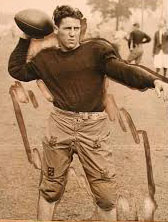|
Football Short Story
1929: Yale's First Trip South
College Football U.S.A. 1869 ... 1972: Official Book of the National Football Foundation,
John McCallum and Charles H. Pearson The late George Trevor, Ivy League historian, told us before he died in 1951 that his introduction to southern football came early in 1929 when he went with Yale, his Alma Mater, on its ill-fated argosy to the little town of Athens to play the University of Georgia. The week previously, the Elis had run up more than 80 points on little Vermont and thus were cozily confident of a victory over Georgia.
Their attack was built around Little Boy Blue, otherwise known as Albie Booth, the mighty midget of Ivy League football. Later that season Albie was to run through one of Army's greatest teams for three touchdowns in an uncanny exhibition of artful dodging. Scouts later discovered that the best way to stop Booth was to hit him high. Tacklers who went for his twinkling feet usually came up with chunks of air. Though he weighed only 144 pounds, Albie was a cocky little cuss and bounced up like a rubber ball. Oddly enough, Booth was not especially fast, but he had the best cross-step and hip-shift seen in college football up to that time.
   L-R: Albie Booth, Red Leathers, Catfish Smith Never did a more confident cunch of players set forth on a football trip as that 1929 Yale team headed for their Waterloo in the Cotton Belt. This was the first time that a Yale eleven had ever crossed the Mason-Dixon Line. The little town of Athens, with its magnolia trees and its mellow ante-bellum college buildings, seemed to symbolize the Old South. Bright red Confederate battle flags fluttered from every window as the Yale Special pulled into the station. Gay flares burned in the streets that night as the Georgia band paraded playing "Dixie."
Taking a walk that evening, Mal Stevens, the Yale coach, bumped into Red Leathers, Georgia's gigantic guard.
"What do you fellows think of tomorrow's game?" asked Stevens amiably.
"Ah dunno, coach," drawled Leathers, "but ah sure hope ol' Joejah is proud o' me."
Stevens rushed back to the hotel where his complacent Yale players were quartered and broke the bad news. "Fellas," he said, you're in for an awful trimming tomorrow. These guys don't know the Civil War is over."
  The Yale coach called the turn. Under a tropical sun, with the temperature in the 90's, Georgia's inspired team dedicated its brand new stadium with a smashing 15-0 win over the shocked visitors. A barefoot kid from the red-clay hills of Georgia took personal charge of Albie Booth that afternoon. Catfish Smith, a tall, brawny end, spent a happy time in the Yale backfield sitting on Albie's neck. After one particularly vicious tackle, Albie sprung to his feet, protesting: "Look here, Smith, there are some things that don't go in this game!"
"I know it!" Catfish retorted. "And one of 'em is Albie Booth!"
Catfish Smith caught a touchdown, and Red Leathers made "ol' Joejah" proud of him by blocking a kick, which the irrepressible Smith converted into another score. To add to Yale's humiliation, Catfish threw Booth ignominiously in the end zone for safety.
Down at the railroad station later, where the Yale Special waited, all was gloom. The electric generators went on a sympathetic strike, leaving Yale partisans to grope their way through the pitch-dark aisles of the sleeping car. It developed that the locomotive had jumped the track, and southern crews made vain attempts to lift it back on the rails. Finally, a New Haven railroad executive showed them to do it—the only victory scored by the North that day!
|